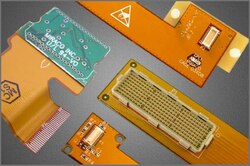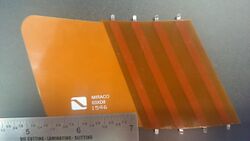Engineering:Flexible circuit
Flexible circuits (also variously referred to around the globe as flex circuits, flexible printed circuit boards, flex print, flexi-circuits) are members of electronic and interconnection family. They consist of a thin insulating polymer film having conductive circuit patterns affixed thereto and typically supplied with a thin polymer coating to protect the conductor circuits. The technology has been used for interconnecting electronic devices since the 1950s in one form or another. It is now one of the most important interconnection technologies in use for the manufacture of many of today's most advanced electronic products. In practice there are many different kinds of flexible circuits, including one metal layer, double sided, multilayer and rigid flex circuits. The circuits can be formed by etching metal foil cladding (normally of copper) from polymer bases, plating metal or printing of conductive inks among other processes. Flexible circuits may or may not have components attached. When components are attached, they are considered by some in the industry to be flexible electronic assemblies.
Rigid flexible
Rigid flexible circuits can have circuit boards both externally or internally. They consist of multiple inner layers of flexible circuits. Advantages in rigid flexible circuits include high reliability and flexibility in design options.[1] Rigid flexible circuits contain more materials than flat flexible circuits. The materials include rolled annealed copper, electro deposited copper, epoxy, acrylic, pre-preg, pressure sensitive, adhesiveless base material, FR-4, polyimide, polyester, solder mask, flexible solder mask, and photo image-able cover lay.[2] Rigid flexible circuits are found in electronic products in many areas, such as, in the military and the medical field.[3]
Flat flexible
Flat flexible circuits are able to fold into nearly any shape due to their flexibility and smaller size. Although they are small and light-weight, they are durable and capable of handling high density.[4] Materials in flat flexible circuits include bare copper, tin-plated copper, acrylic, pressure sensitive adhesives, polyester, photoinduced electron transfer, polyethylene naphthalate, tin, conductive silver ink, and aluminum or copper tape.[5] Typical applications of flat flexible circuits include plotters, copiers, and printers.[6]
Advantages
There are many advantages that come with using flexible circuit technology beyond the initial flex capabilities. Performance advantages, such as, dynamic flexing and increased heat dissipation allow engineers to design these circuits into applications where extreme temperatures and vibrations are common. Other advantages with using flexible circuits include less weight, increased package density, and a more integrated design.[7] Flexible circuits can cost less than traditional assemblies because one flex assembly can replace several, single circuits.[8]
Flex circuits also allow design engineers to utilize space three dimensionally which cuts down on the overall footprint of the circuit and saves space.
Applications
Applications of flexible circuits ranges in a variety of fields. Flexible circuits are used in cell phones, LCD televisions, antennas, and laptops. Flexible circuits have evolved and help provide durability and reliability. Flexible circuits are also used in the aviation field.[9] Other applications of flexible circuits are in hearing aids, calculators, cameras, printers, and in satellites.[10]
See also
References
- ↑ "Rigid Flexible Circuits". Flexible Circuits. http://www.flexiblecircuit.com/products/rigid-flex/. Retrieved April 2, 2015.
- ↑ "Materials". Flexible Circuits. http://www.flexiblecircuit.com/products/rigid-flex/materials.php. Retrieved April 2, 2015.
- ↑ "Applications". Flexible Circuits. http://www.flexiblecircuit.com/products/rigid-flex/applications.php. Retrieved April 2, 2015.
- ↑ "Flat Flexible Circuits". Flexible Circuits. http://www.flexiblecircuit.com/products/flat-flex/. Retrieved April 2, 2015.
- ↑ "Materials". Flexible Circuits. http://www.flexiblecircuit.com/products/flat-flex/materials.php. Retrieved April 2, 2015.
- ↑ "Applications". Flexible Circuits. http://www.flexiblecircuit.com/products/flat-flex/applications.php. Retrieved April 2, 2015.
- ↑ "A Review of Flexible Circuit Technology and its Applications". Prime Faraday Technology Watch. http://www.lboro.ac.uk/microsites/mechman/research/ipm-ktn/pdf/Technology_review/flexible-circuit-technology-and-its-applications.pdf. Retrieved April 27, 2015.
- ↑ "Why Flexible Printed Circuit Board (PCB) - AirBorn Flexible Circuits (AFC)". https://www.airborn.com/products/flexible-circuits/why-flex-.
- ↑ "A Review of Flexible Circuit Technology and its Applications". Prime Faraday Technology Watch. http://www.lboro.ac.uk/microsites/mechman/research/ipm-ktn/pdf/Technology_review/flexible-circuit-technology-and-its-applications.pdf. Retrieved April 27, 2015.
- ↑ "Applications". Flexible Circuits. http://www.flexiblecircuit.com/products/flat-flex/applications.php. Retrieved April 2, 2015.



